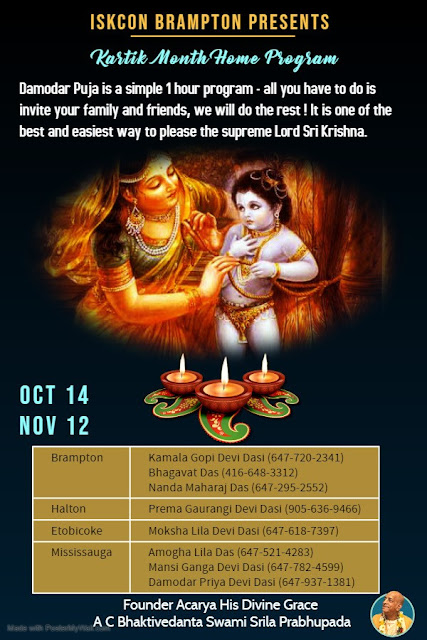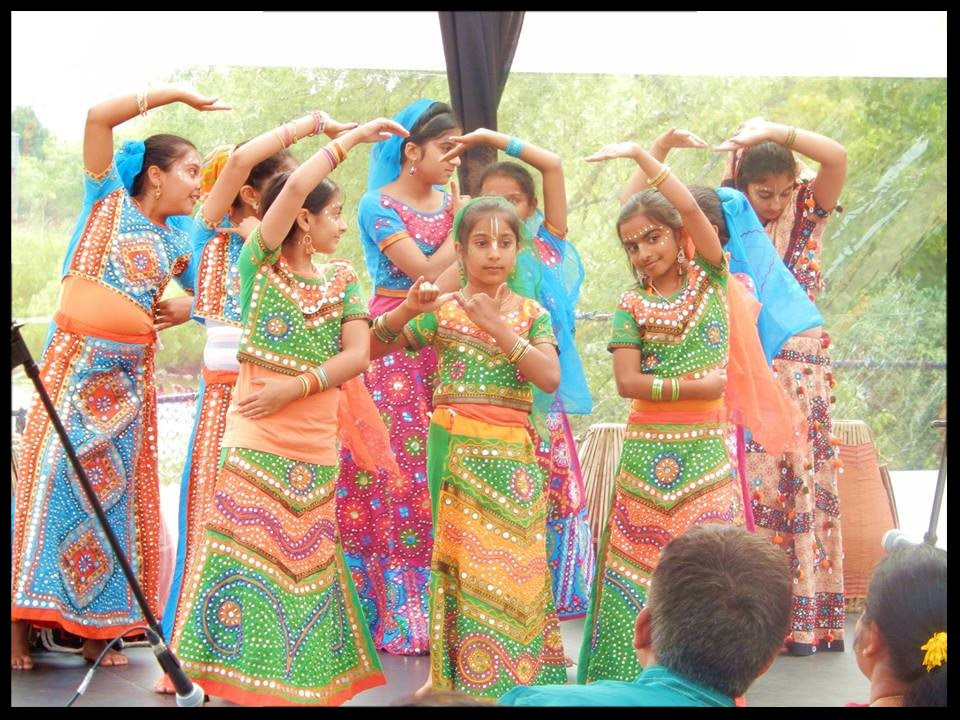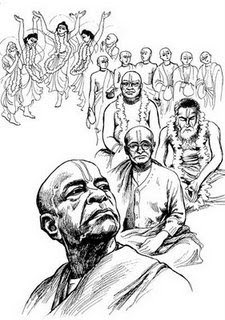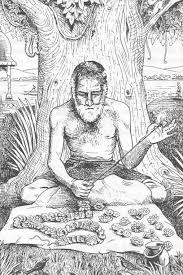 Today is the disappearance day of Srila Gaurakisora dasa Babaji Maharaja. Srila Gaurakisora dasa Babaji was a great devotee—a maha-bhagavata. He was a disciple of Srila Bhaktivinoda Thakura and was very renounced. Earlier, he lived for many years in Vrindavan, roaming the twelve forests, chanting the holy names of Krishna, begging alms, and sleeping under trees. Later, after Srila Bhaktivinoda Thakura discovered Lord Chaitanya’s birthplace in Mayapur, Srila Jagannatha dasa Babaji Maharaja, the siksa-guru of Bhaktivinoda Thakura and parama-guru of Gaurakisora dasa Babaji, instructed Gaurakisora to move to Navadvipa-dhama.
Today is the disappearance day of Srila Gaurakisora dasa Babaji Maharaja. Srila Gaurakisora dasa Babaji was a great devotee—a maha-bhagavata. He was a disciple of Srila Bhaktivinoda Thakura and was very renounced. Earlier, he lived for many years in Vrindavan, roaming the twelve forests, chanting the holy names of Krishna, begging alms, and sleeping under trees. Later, after Srila Bhaktivinoda Thakura discovered Lord Chaitanya’s birthplace in Mayapur, Srila Jagannatha dasa Babaji Maharaja, the siksa-guru of Bhaktivinoda Thakura and parama-guru of Gaurakisora dasa Babaji, instructed Gaurakisora to move to Navadvipa-dhama.
There Gaurakisora resided on the banks of the Ganges and practiced devotional service with intense devotion and renunciation. Because materialistic men would come and disturb him with their desires for mundane blessings (asirvada), the babaji began to stay by a municipal lavatory, where the filth and obnoxious smells would discourage unwanted visitors. There he would chant in peace—in ecstasy. He would beg alms and cook in discarded clay pots, or eat parched rice with green chilies, or just ingest Ganges mud. Sometimes he would collect the discarded cloth from the crematorium, wash it in Ganges water, and use it to cover himself. His only desire was to be absorbed in the mellow of the holy name—in Krishna consciousness.
Gaurakisora was a siksa disciple and intimate friend of Srila Bhaktivinoda Thakura. The Thakura arranged a bhajana-kutira for him on the same property as Bhaktivinoda Thakura’s house in Godruma-dvipa. When the time came for Srila Bhaktisiddhanta Sarasvati Thakura to take diksa, Srila Bhaktivinoda Thakura advised him to approach Srila Gaurakisora dasa Babaji Maharaja. Srila Bhaktivinoda Thakura was the father of Bhaktisiddhanta Sarasvati and his first instructor in the spiritual science, but the etiquette was that one would not take diksa from one’s biological father. So Srila Bhaktivinoda Thakura sent him to Gaurakisora dasa Babaji Maharaja.
Srila Bhaktisiddhanta Sarasvati Thakura was highly literate. By the age of seven, he had memorized the entire Bhagavad-gita and could even explain its verses. He had a photographic memory, and in school he read all the books in the entire library. Just by reading them once, he could remember every word, and so the library purchased new books just for him. By the age of twenty-five, he had written numerous articles and published one book, Surya-siddhanta, for which he was awarded the title “Siddhanta Sarasvati.” So he was highly educated and literate, and Srila Gaurakisora dasa Babaji Maharaja was hardly educated or literate at all.
The first time Siddhanta Sarasvati approached Srila Gaurakisora dasa Babaji Maharaja, the babaji refused to accept him. He didn’t directly say no, but he said, “I will ask Mahaprabhu.” When Siddhanta Sarasvati returned and told his father what had happened, Srila Bhaktivinoda Thakura encouraged him to persevere: “You must go back and beg him with all humility and earnestness to accept you.” So he went back, and Gaurakisora dasa Babaji again refused, saying, “Oh, I forgot to ask Mahaprabhu. I am so sorry.” When Siddhanta Sarasvati returned home, Srila Bhaktivinoda Thakura was most upset. He knew that Gaurakisora dasa Babaji was a pure devotee, a maha-bhagavata, and he urged Siddhanta Sarasvati to persist. So he again instructed his son to beg Gaurakisora for his mercy, and he added, “If you fail this time, don’t bother to come back home.”
So Siddhanta Sarasvati left the house and went to the Ganges. He felt so hopeless, he thought he might as well just drown himself in the river. Just then, Srila Gaurakisora dasa Babaji Maharaja appeared; he knew what was in his future disciple’s heart. Siddhanta Sarasvati just threw himself at the lotus feet of Srila Gaurakisora dasa Babaji in abject humility and complete surrender. Finally, Srila Gaurakisora dasa Babaji accepted him. Siddhanta Sarasvati had shown that he was free from any tinge of false pride, that he was so learned and literate and his guru was uneducated.
Srila Prabhupada remarked that Gaurakisora dasa Babaji was illiterate and could not even sign his name, yet he became the spiritual master of Sarasvati Thakura, the best scholar of his time. And thus he proved the statement of the Vedas:
yasya deve para bhaktir
yatha-deve tatha gurau
tasyaite kathita hy arthah
prakasante mahatmanah
“Only unto those great souls who have implicit faith in both the Lord and the spiritual master are all the imports of Vedic knowledge automatically revealed.” (Svetasvatara Upanisad 6.23)
Although Gaurakisora dasa Babaji was hardly educated or literate, learned scholars and public servants would approach him with their questions on Srimad-Bhagavatam and other shastras, and with his realized knowledge he would answer their questions to their full satisfaction. Sometimes devotees would read various scriptures for him and he would comment on them from his deep spiritual realization.
Still, out of his great humility Srila Gaurakisora dasa Babaji Maharaja refused to accept any disciples, and Srila Bhaktisiddhanta Sarasvati Thakura proved to be the only exception.
Gaurakisora dasa Babaji enjoined Bhaktisiddhanta Sarasvati never to go to Calcutta, which he considered “a bastion of Kali-yuga.” So Bhaktisiddhanta Sarasvati remained in Mayapur. In 1905 he took a vow to chant the Hare Krishna mantra a billion times. Residing in a grass hut near the birthplace of Lord Chaitanya, he chanted the Hare Krishna mantra day and night. He cooked rice once a day in an earthen pot (or just parched the rice in the sun) and ate nothing more. He slept on the ground, and when the rainwater leaked through his grass ceiling, he sat beneath an umbrella, chanting. Locked in a small room, he chanted japa day and night, day after day, month after month, year after year. Finally, when he had completed his quota, he felt that he was ready to come out and preach. And to preach he went to Calcutta.
In a talk at the Ardha-kumbha-mela in Allahabad, Srila Prabhupada raised the point that Srila Gaurakisora dasa Babaji had instructed Bhaktisiddhanta Sarasvati never to go to Calcutta but that everyone knows he went to Calcutta. So, Srila Prabhupada questioned whether Bhaktisiddhanta Sarasvati had disobeyed the orders of his spiritual master. “No!” Srila Prabhupada declared. “He was never in Calcutta; he was always in Vaikuntha!”
So, we pray to Srila Gaurakisora dasa Babaji:
namo gaura-kisoraya
saksad-vairagya-murtaye
vipralambha-rasambodhe
padambhujaya te namah
He is saksad-vairagya-murtaye, the personification of renunciation (vairagya); and vipralambha-rasambodhe, always merged in the ocean of the mellow of separation from Krishna (vipralambha-rasa). Padambhujaya te namah: “I offer my respectful obeisances unto his lotus feet.”
That was the mood of Srila Gaurakisora dasa Babaji Maharaja: he was always merged in that nectarean ocean of devotion in separation, and he had no care for his body or for anything material—just hari-nama.
He wrote a beautiful song that is completely in the mood of Raghunatha dasa Gosvami. It is said that of the Six Gosvamis, Raghunatha dasa was the most attached to the service of Srimati Radharani—that he had the most intense desire to serve Srimati Radharani—and Gaurakisora dasa Babaji wrote a beautiful song completely in that mood. He begins with a refrain: kotai go premamayi, radhe radhe, radhe radhe—“Where is Radha, so full of love? Radhe, Radhe, Radhe, Radhe!” Then he proceeds to express the mood of Raghunatha dasa Gosvami in separation from Radharani, desiring and aspiring for Her service.
When Srila Gaurakisora dasa Babaji Maharaja left this world, there was some dispute over what would happen to his body. His samadhi would, of course, become an important place of pilgrimage, and some of the heads of the local Vaishnava centers saw this as an opportunity to raise money—for their mathas and even for their own sense gratification. Srila Bhaktisiddhanta Sarasvati ran to the site, but when he arrived, some of the local babajis objected: “You are not a sannyasi; how can you give samadhi to such an exalted and renounced personality?” But Srila Bhaktisiddhanta Sarasvati responded forcefully: “I am the only disciple of Babaji Maharaja, and although I have not accepted sannyasa, I am a celibate brahmachari, not secretly addicted to abominable habits or involved with illicit activities. Who among you can say that in the last year he had no sex or illicit contact with a woman? Please step forward.” Everyone was silent. Then he challenged, “Who has refrained for the last six months?” Everyone was silent. Next, “For the last three months?” Again, silence. “For the last one month?” Silence. “The last three days?” Still silence. They had been exposed and humbled. Not one of the babajis was fit to even touch the transcendental form of Srila Gaurakisora dasa Babaji Maharaja, and one by one they walked away.
But even then there remained some question about how to handle the body, which was still lying on the ground. Out of his great humility Srila Gaurakisora dasa Babaji Maharaja had instructed that when he departed, his body should be dragged through the streets of Navadvipa so that it would be bathed in the dust from the feet of the Vaishnavas who had walked the holy ground of the dhama. So some of the townspeople proposed to take the body and drag it through the streets of Navadvipa. Such fools! Such rascals! But Bhaktisiddhanta Sarasvati Thakura stopped them. “Although we are fools and offenders,” he said, “still we can try to understand the true meaning of Babaji Maharaja’s humble request. After the departure of Thakura Haridasa, Lord Chaitanya Himself took the spiritually blissful body of the Thakura on His lap and danced. Following the divine example of Mahaprabhu, let us also bear Babaji Maharaja’s blissful body on our own heads.”
So Srila Bhaktisiddhanta Sarasvati took charge of the body and placed it in samadhi on the western side of the Ganges, across from Mayapur. In time, the course of the Ganges changed and its waters threatened the area of the samadhi. So Srila Bhaktisiddhanta brought the samadhi to Mayapur, to his matha. There he had created a replica of Vrindavan, with tamala trees and kadamba trees, with Syama-kunda and Radha-kunda, and with a small Govardhana Hill made of govardhana-silas. Most appropriately, he placed the new samadhi by the side of Radha-kunda, and that is where the transcendental remains of Srila Gaurakisora dasa Babaji still rest today. One can go there and pray to him and feel his presence and get his mercy.
Srila Gaurakisora dasa Babaji Maharaja is an ocean of mercy (all pure Vaishnavas are). I pray that he will help me to chant the holy name, to chant with taste. When I prayed to him earlier—and this may just be my speculation—I imagined that he said, “You must give up your offenses.” Then I was thinking, “What offenses? What offenses?” And then I imagined that he answered, “You must chant with attention.”
Of course, Srila Bhaktivinoda Thakura does state that inattentive chanting is the root of all other offenses and that, conversely, attentive chanting will destroy all the other offenses. “But how do I do that?” I asked. And the answer came: “You must try. You just have to make the effort.” And I suppose that is always the process—that we make our honest effort and depend on the mercy of the acharyas and Krishna.
In my case, however, my chanting sometimes becomes such a routine that I do not even make the effort to hear every word or every mantra. I just do it. I just go through the motions. So I guess that is my challenge, my special order—to chant with attention.
Devotees often raise the question of chanting with quality. When on a morning walk a disciple asked Srila Prabhupada, “How can we chant with quality?” His Divine Grace replied, “The quality will come. For now just chant as a matter of duty; chant your sixteen rounds. When the quality comes, there will be no force. You will have taste, and spontaneously you will desire, ‘Why sixteen rounds? Why not sixteen thousand rounds?’ Rupa Gosvami desired, ‘How shall I chant with one tongue and hear with two ears? Had I billions of tongues and trillions of ears, then I could enjoy it.’ ”
Srila Prabhupada said that quality means asakti, attachment, and that Chaitanya Mahaprabhu showed that quality: “Sunyayitam jagat sarvam govinda-virahena me: ‘Oh, I do not see Govinda. The whole world is vacant.’ Sunyayitam jagat sarvam govinda-virahena me. This is quality.” When one feels viraha-bhava, when one feels separation from Radha and Krishna, one is chanting with quality.
Srila Gaurakisora dasa Babaji is an ocean of mercy, and we pray for his grace.
Hare Krishna.
[A talk by Giriraj Swami on Srila Gaurakisora dasa Babaji’s disappearance day, November 22, 2004, Dallas]

 By Yogesvara Gopinath das
By Yogesvara Gopinath das

 Sadbhuja Das: Hare Krishna everyone!
Please have a look at this short video clip of a progress report of some exterior works, located at the front entrance at the temple. This is quite a monumental piece of embellishment, which I think you all will find very interesting.
Sadbhuja Das: Hare Krishna everyone!
Please have a look at this short video clip of a progress report of some exterior works, located at the front entrance at the temple. This is quite a monumental piece of embellishment, which I think you all will find very interesting.



 Utpanna Ekadasi
Utpanna Ekadasi




 By Krishna Ksetra Swami
By Krishna Ksetra Swami
















 Mukhya devi dasi: Tuesday, November 5, 2019, there was a Panel Discussion with the Bhaktivedanta Institute devotees in the Temple room at 7:00 PM. They gave us an overview of what the BI is working on right now, and they took our questions, everything we always wanted to know about the integration of science and Krishna consciousness.
Mukhya devi dasi: Tuesday, November 5, 2019, there was a Panel Discussion with the Bhaktivedanta Institute devotees in the Temple room at 7:00 PM. They gave us an overview of what the BI is working on right now, and they took our questions, everything we always wanted to know about the integration of science and Krishna consciousness.
 Tamohara dasa: Many of you are aware of the recent increase in “active shooter” events in many different places and venues. Unfortunately, places of worship have not been immune from these attacks, which have recently occurred in churches, and synagogues. While the chances of such an attack in any one particular location are remote, it is better to be properly prepared for anything, including attacks, natural disasters, or any emergency situation.
Tamohara dasa: Many of you are aware of the recent increase in “active shooter” events in many different places and venues. Unfortunately, places of worship have not been immune from these attacks, which have recently occurred in churches, and synagogues. While the chances of such an attack in any one particular location are remote, it is better to be properly prepared for anything, including attacks, natural disasters, or any emergency situation.
















 Parasuram das: Each night the Kartika Moon grows, when the moon becomes full, the Purnima, another 6 days to go, that will be a sad day, as it means the end of the Vraj Mandala Padayatra and the team will be heading back to their respective countries.
Parasuram das: Each night the Kartika Moon grows, when the moon becomes full, the Purnima, another 6 days to go, that will be a sad day, as it means the end of the Vraj Mandala Padayatra and the team will be heading back to their respective countries.


















